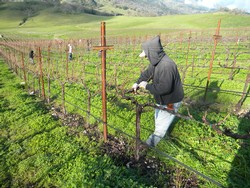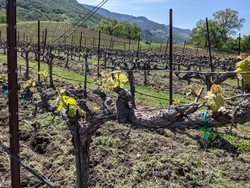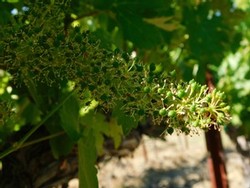Field Craft: Rangeland's Annual Cycle
At Rangeland, we often say that our wines are "field crafted." Although indoors winemaking is important, our wine really is grounded in the vineyard, where we grow our delicious grapes. The diverse soils, warm climate, high elevation, southwest facing aspect and coastward location are all particularly special at our Adelaida Springs Ranch estate vineyard, but the human component is just as important. There are 7 critical stages in the yearly life cycle of our vineyard that require management: pruning, bud break, shoot thinning, bloom, canopy management, veraison and harvest.
Pruning: While They are Sleeping...

Bud break: Rebirth
 We leave about 12 spur positions on each vine and each spur has two or three buds. These buds, formed the previous year, will be the start of this year's crop. They open up and sprout leaves in the first few weeks of spring. This is what we call "bud break." The vines are coming out of a long winter's nap and starting the yearly cycle. Each bud will grow a 3-4 foot, hopefully fruit-bearing cane, in the coming months.
We leave about 12 spur positions on each vine and each spur has two or three buds. These buds, formed the previous year, will be the start of this year's crop. They open up and sprout leaves in the first few weeks of spring. This is what we call "bud break." The vines are coming out of a long winter's nap and starting the yearly cycle. Each bud will grow a 3-4 foot, hopefully fruit-bearing cane, in the coming months.
Shoot Thinning: Taming the Beast
Grapevines are prolific. Despite careful pruning, a healthy vine wants to push extra shoots out, to grow more grapes and seeds for birds (and other critters) to eat, spread and reproduce. So each May, "we" (our labor crew/small army) thin shoots by gently breaking off all of those excess shoots on every plant by hand, allowing the vine to focus its energy on the choice remaining growth. Fine wine grapes need a rough balance between leaves (that act like ripening solar panels) and fruit.
Bloom and Set: Heaven Scent

Canopy Management: Training the Ballerina
Once the canes are fully grown by about the 4th of July, we have to manage them. First, we need to be able to get the tractor down each row, so we lift the shoots with trellis wires. And secondly, we want the grapes to get enough sunlight to develop color and tannins, but we don't want sunburn or shrivel. We flop and fluff the canopy on the sunny morning side to provide some speckled shade. On the shadier afternoon side, we pin the shoots all the way up with wires to get better sun exposure. Our vines end up looking like a ballerina with one arm stretched gracefully to the side. It is not a perfect science, but we strive for fruit intensity and complexity through sun exposure.
Veraison: The Blushing Change
.jpg) Red wine veraison is when the grapes darken and soften. The fruit’s acidity starts to decline and harvest is only 4-6 weeks away. This is a major change, much like puberty for an adolescent, and this is when character and flavor starts to develop. After 2-3 weeks, we do what's called a "green drop", when anything that hasn't turned color yet, is dropped on the ground. This helps the vineyard ripen uniformly. It allows the vine to concentrate its ripening power on the remaining fruit.
Red wine veraison is when the grapes darken and soften. The fruit’s acidity starts to decline and harvest is only 4-6 weeks away. This is a major change, much like puberty for an adolescent, and this is when character and flavor starts to develop. After 2-3 weeks, we do what's called a "green drop", when anything that hasn't turned color yet, is dropped on the ground. This helps the vineyard ripen uniformly. It allows the vine to concentrate its ripening power on the remaining fruit.
Harvest: Off to College
Harvest is the time when the parent vine ships their little grape children off to college so they can learn what they were meant to become! We start measuring grape sugar content and acidity in August, but ultimately I decide when to pick based on fruit flavor. This usually occurs in September and through the middle of October. We hand harvest all of our grapes, and I’m on almost every pick. While the grapes are being picked into the bins, I am standing on the trailer pulling out leaves and under-ripe fruit, while tasting the grapes to see what I want to do with them once they get to the winery. For instance, if there is a lot of tannin in the skins, I might decide to do gentle pump-over during fermentation instead of a more extractive punch down.
Art and Science
This is, of course just a glimpse at the process. Growing good grapes and making fine wine involves a lot technical knowledge and measurement. But ultimately the process is so complex—Laird calls it kaleidoscopic—that the key decisions are artistic. That suits me very well.
How I Learned to Love Paso Robles
Until I moved to Paso Robles 3 years ago, I did not have the best opinion of this region. I know this sounds bad, but hear me out. The reality is that within the broader wine industry, professionals (many of whom have not actually visited Paso) have a preconceived notion that Paso wine is over-ripe, over-alcoholic, unbalanced and therefore, not worth their time. Not so for consumers, however--typical wine consumers just drink what they like and are less likely to be bogged down by current trends and/or winemaking dogma. Paso wine is delicious and equitably priced for the most part.
I am both a wine consumer and winemaker, so my opinion was formed by my experiences in the industry. Before I moved here, I had worked in Sonoma County, the Willamette Valley in Oregon, in Woodinville and Walla Walla, Washington, and I felt like I had a pretty good grasp on American wine culture. In my mind, Paso Robles was that region too hot and too far south to make great wine, and most of the wines I had from the early 2000’s confirmed my theory.
Oh, how wrong I was.
When I first moved to Paso in 2013 for an assistant winemaker job, I quickly realized that I had grossly oversimplified the region in my mind. Not only is Paso diversified in its soil types and microclimates, but there is also an array of varietals and winemaking styles. While I still don’t particularly like many "big" Paso wines from the past (just my personal taste), I was wrong to assume that the region could not evolve into a world-class wine region.
Now that I’ve worked here for 3 years, I feel that Paso Robles is a premier region in the U.S. to grow Grenache, Mourvedre, Cabernet Sauvignon, and several other varietals that are making an impressive mark in a highly competitive marketplace. Of course, not all wine in Paso is unicorns and rainbows (just like any wine region) but the potential here is certainly tangible. The interesting thing is that I doubt I would have discovered this potential without fully immersing myself here.
Paso Robles is a wine region that needs to be visited in order to be fully understood. You must drive through the back roads of the Paso foothills to find little morsels of tastiness. You have to experience the energy of the wine industry and the town itself in order to fully appreciate the wines—the atmosphere is something unlike anywhere else I’ve worked. As a winemaker, it is exciting to be part of a burgeoning and innovative wine culture that more and more people are experiencing for the first time.
Adelaida Springs Ranch is also a place that needs to be visited in order to truly understand Rangeland Wines and the land’s beauty. The dusty green canopy of vines and oak trees contrasted against the golden hills of oats is something to behold—especially while drinking a glass of rosé.
Cheers!
Paul
The Wine Whisperer
In Like a Lion, Out Like a Lamb
Spring is a magical time of year here on the ranch: green grass is in abundance, all the vines are pruned and looking dapper, 130 baby lambs are frolicking around like kids in a Chuck E. Cheese, and of course, budbreak is just starting in the vineyard.
During the (not so) long, (not so) cold winter in Paso Robles, the grape vines go into dormancy where they can store up their energy, uptake water and get ready for another year of producing delicious grapes. The vines aren’t “asleep” exactly, but taking a kind of “staycation” between the grueling previous harvest and the upcoming growing season. This dormant state is not unlike a troubled poet who holes up in a secluded cabin, waiting for inspiration to snap her out of her writer’s block blues. Budbreak—when leaves first sprout on the vines—is the humble beginnings of what eventually will be, to stay with the previous metaphor, bottled poetry.
2016 now has the earliest budbreak on record in Paso Robles, even though 2015 held the non-coveted title last year—an early budbreak can be bad news. For us at Rangeland, it means we have to pull the sheep from the vineyard for the season. We like grazing our sheep in the vineyard because it is an effective way of mowing the grass and spreading nutrient-rich manure into the soil; but after budbreak we don’t want them eating the new leaves off the vines. In terms of vineyard health, early budbreak means the vines may not have had sufficient time in their dormant state and therefore might not have stored up enough energy for the upcoming season. This can put extra stress on the vines—unfortunately, there isn’t much we can do about it except to delay pruning until the last moment, which we did. Early budbreak also creates a higher chance of frost damage since the weather can turn freezing in March and April. Fortunately for Rangeland, frost risk is low in our vineyard since it is located on a high hillside, allowing cold air to sink down into the Jack Creek drainage below, leaving our vines unharmed.
This intricate dance with Mother Nature is part of what it means to be a grape grower. Just like writing a good poem requires both structure and spontaneity, growing excellent grapes requires sound vineyard practices while staying flexible through Mother Nature’s whims.
To close, I’ll paraphrase 18th-century British poet, Samuel Johnson: wine “puts in motion what had been locked up in frost.
Until Next time, Cheers!
Paul, the Wine Whisperer
If you are interested in watching videos of lambs and/or a very cool video on vine pruning made by our ranch manager, Nathan Stuart, please check us out on Facebook.
The Lamb Whisperer?
One of the many reasons I love my job is that I rarely have to do the same thing two days in a row. Whether I’m in the cellar, filing government paperwork, or herding sheep--most days I don't know what excitement awaits me. My official title at Rangeland is Winemaker. For some, this might conjure up an image of me swirling a glass of cabernet all day and mumbling pompous comments about the wine’s nuances of purple petunias and tiger sweat. Others might think that I just sit in my office and write work-orders for my inferiors to complete. In reality, because we are a small winery, I am also the assistant winemaker, cellar worker, and intern/peon. I wash the barrels, clean the drains and I even harvest my own tiger sweat. On top of my cellar duties, I also help out on the ranch with cows, sheep, vineyard projects and basically whatever Laird or Nathan tell me to do. So although my task list may not seem as glamorous as most people’s expectations, I prefer to have some grit in my job description--even if that means shoveling sheep excrement.
This week, Ranch Manager Nathan, Eddie ("retired" and does everything) and I have been building fence around the barn in preparation for lambing season. Constructing livestock fencing is so much harder and more precise than I would have ever imagined. Fortunately, Nathan and Eddie have been extremely patient with me while I am learning the rudiments of fencing--they give me the easy jobs so I can feel good about myself. It is times like these that I feel truly humbled as a weakling winemaker since I can’t seem to keep up with Eddie, who I’d wager is twice my age.
I don’t really know exactly what ‘lambing’ is going to entail just yet, but we are expecting to have 250 baby lambs born within the next few weeks! I can’t wait to be surrounded by so much cuteness. I have this bucolic image of myself dressed in shepherd garb cradling a newborn lamb and keeping it warm while I sing it to sleep with a soft lullaby. Then doing it 249 more times. However, I’m pretty confident that won’t actually happen. I may just end up covered in feces, cursing a lot, with my dignity shattered. But that’s what makes a better story, right? Stay tuned on that one.
So this is my first blog, and I’m not exactly sure where I want to go with it just yet. I’m not confident that anyone other my mom will even read it. Nonetheless, I plan on writing about wine-oriented topics such as the soil’s effects on wine, Paso Robles’s place in the wine world, and the relationship between wine scores, popularity, and price. Ideally, I would love it if our club members would ask wine questions of me in an “Ask Amy” sort of way. I could be your own personal wine butler, who answers to your every question. I shall call myself… the Wine Whisperer. (Apparently, there is already a trademarked ‘Wine Whisperer’ but I thought of the name idependently.)
For questions or comments, please email me at paul@rangelandwines.com or comment below.
Until next time, Cheers!
Paul, The Wine Whisperer
Keep up to date on the latest wine releases, events, and promotions and get 10% off your next order.